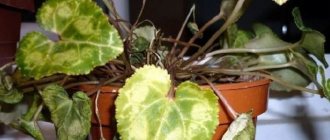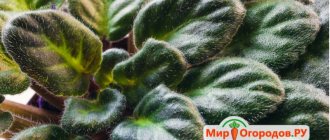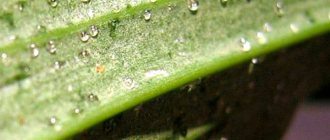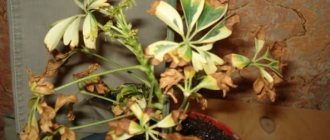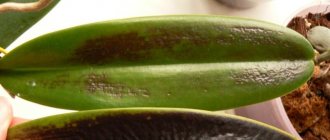Spathiphyllums are often used in interior design, because these plants with exquisite white flowers are unpretentious and are perfect for growing at home.
In nature, spathiphyllum grows in the lower tier of tropical forests, so at home it is better to provide it with conditions similar to its natural habitat. Unfortunately, it is not always possible to properly care for the flower, and its leaves begin to turn black. In this article we will look at the reasons that can cause such a process, as well as ways to combat blackening.
- The leaves turn black at the tips
Reasons for blackening of the foliage of the “female happiness” flower
Why do the leaves dry out and then darken around the edges?
The following factors lead to blackening of leaf edges:
- Insufficient air humidity . Spathiphyllum is a tropical crop, so it loves humid air (from 55-60%). In addition, a real test for a plant is not only dry, but also cold air. This leads to burns and death of the root system. And the first sign of rotting of the rhizome is dry and dark ends of the foliage.
- Sunburn . For spathiphyllum, partial shade is considered optimal light conditions. If a grower places a plant in the sun, its leaves immediately become covered with burns.
- Drafts or sudden temperature changes . Leaf plates react sharply to changes in air temperature, especially to its decrease. The leaves immediately turn yellow, dry out, and then turn black. The same effect occurs due to drafts.
If only the tips change color
The tips of spathiphyllum leaves first dry out, turn yellow or brown, and then darken for the following reasons:
- Lack or excess of nutrients . The soil becomes poorer over time, so the crop requires regular fertilizing. But you should not apply too much fertilizer. The most important thing in this matter is regularity and dosage. The optimal time for feeding is spring, the beginning of the flower growing season.
- Stagnation of moisture in the soil . This happens due to excessive moisture of the substrate. It is impossible to flood the plant; it is important to ensure that the soil is moistened, but that swampiness does not form. Also, check whether the pot has drainage holes and whether there is a drainage layer at the bottom of the pot. You also need to pay attention to the permeability of the soil. Perhaps the substrate is clogged, so the flower needs to be replanted.
What causes greenery to completely darken, what diseases can it be affected by?
The leaf blades turn completely black if all of the above negative factors are not eliminated. Also, the leaves turn completely black when infected with fungal infections.
In this case, the foliage becomes covered with black spots along the entire perimeter. Over time, this pigmentation turns into one large spot.
Additional signs of the presence of fungal diseases are the loose structure of the leaves of the “female happiness” flower; it becomes moist.
Below are photos of the affected leaves:
Reference! Often, in addition to black, brown spots also appear on the leaves. This indicates that the fungus has affected the root system.
The development of fungus is caused by low air temperatures and stagnation of water in the soil.
Signs of dry and wet blackening of spathiphyllum leaves
A healthy plant is distinguished by rich green leaves with a dense structure. Spathiphyllum grows quickly and blooms regularly. There are no inclusions on the leaf plate. If a flower begins to lose any of these characteristics, this may indicate illness or improper care.
Spathiphyllum with blackened leaf tips
There are 2 types of blackening:
- Dry. The leaves turn black, dry out and begin to crumble.
- Wet. It is characterized by rotting of the leaf plate; fungal spores and mold appear on the affected part.
In this way, most often the plant signals improper care or infection with a fungal disease. But if the flowers also begin to turn black, you should start worrying about the health of the spathiphyllum.
Wet blackening of flower foliage
How to care for a plant at home to save it?
If a florist notices the blackening of the leaves of the “female happiness” flower and determines the reasons, then to effectively treat the blackening plant, he needs to perform the following steps :
- Treat the crop with a fungicide. Instructions for dilution and use are on each package.
- Raise the air temperature to +26 degrees.
- Remove the plant from the pot and inspect the roots for fungal damage. If there are rotten parts, cut them off and treat the cut areas with crushed coal.
- Reduce the frequency and abundance of watering by half. The next moistening of the soil should occur after a third of the soil layer has dried.
- Use complex fertilizers. In spring, fertilizing is applied every week. In summer, you can apply once every 10 days. During the rest period, it is allowed to feed the crop for its complete restoration - once a month will be enough.
- Trim off all affected areas of spathiphyllum.
- Spray the plant with water (you can add a growth stimulator to it).
Possible diseases
A change in leaf color may also indicate a more serious problem. Thus, constantly moist soil creates ideal conditions for the proliferation of various harmful bacteria. In most cases, the roots of spathiphyllum begin to rot and it disappears.
To save a flower, you should remove it from the flowerpot and inspect the roots. Cut off all rotten parts. Treat the remaining ones with Fundazol and transplant them into fresh substrate.
Blackening of leaves is always unsightly and dangerous, regardless of the type of plant. If the spathiphyllum begins to turn black, then the problem is serious and needs to be solved quickly. Otherwise, the blackening will begin to spread to neighboring leaves, they will dry or rot, fall off, and over time the crop will die.
What to do if the plant has blackened flowers?
When flowers turn black, the gardener should have the following algorithm of actions::
- Check the soil mixture for flooding. If there is a lot of water in the soil, remove it from the pot and let it dry completely.
- Humidify the air. To do this, place a container of water or moistened expanded clay next to the crop, and also spray it daily with water at room temperature.
- Remove the flower from drafts and direct sunlight.
Blackening of leaves and flowers in spathiphyllum is a common problem. The plant is tropical, so the climatic conditions of our premises are not always suitable for it. The gardener’s task is to provide the crop with conditions optimal for normal growth and flowering.
Blackening of leaves and flowers indicates errors in care, as well as an attack of fungal infections. You need to start reviving the plant immediately after the first signs appear. Otherwise, it may not be possible to save culture.
Black coating on leaves
A blue-black coating on the leaves indicates infection of the apple tree with black cancer
.
Black cancer
The disease is a fungal disease and often leads to the death of the plant. If a sooty coating
, which means the disease is no longer at the initial stage.
Symptoms:
Leaves first
become covered with red or red-brown dots, and only then are they completely affected, forming a solid black coating.
It can appear on both the front and back sides. The leaves dry out and fall off. Already in mid-summer, the apple tree can lose all its foliage.
Treatment:
Treatment of black cancer
carried out in combination, since it is reflected not only on the leaves. Mushrooms cause great damage to bark and branches.
All diseased parts must be ruthlessly cut out
.
Sections are treated with antiseptics:
- Bordeaux mixture,
- copper sulfate
and covered with putty, which also includes antimicrobial agents, for example Fitosporin.
Spraying of affected trees is also necessary. Treatments are carried out two to four times per season with an interval of two to three weeks.
Most effective
spraying is considered, in which systemic fungicides alternate, depending on the active substance.
When thinking about how to treat black plaque on the back of apple tree leaves, you should choose fungicides that combine contact and systemic action: Tercel, Poliram, Delan.
Sooty coating
Having discovered a plaque, you should not despair and assume the worst; there is a chance that the plaque is not a symptom of a serious illness.
It may be formed by fungi, which can be removed by double treatment. A solid black coating can be caused by pests, for example, or.
Treatment:
If found
, several treatments should be carried out, alternating fungicides with insecticides.
The most effective pest control products are those based on cypermethrin:
- Inta-Vir.
- Aktara.
- Actellik.
Helps against plaque
spraying with a copper-soap solution: per bucket of water you need 150 grams of liquid (or grated) soap and 5g of copper sulfate.
How many times a day should I water spathiphyllum?
Needs watering
only when the earthen lump dries well. The plant will report this by drooping leaves. The frequency of watering depends on the time of year: in summer - every three days, in winter - once a week.
Interesting materials:
How to remove the white background of icons? How to remove the white circle on the screen? How to remove the white circle on the Meizu screen? How to remove the white circle on Honor? How to remove endless grenades in cs go? How to remove safe mode on a laptop? How to remove tickets from Wallet? How to remove Bing from Windows 10 search? How to remove blocks with a command in Minecraft? How to remove administrator lock?
Lily
Unlike the plants described above, lily poses a real danger to humans if this flower is grown in the house.
The flowers of this elegant plant emit carbon dioxide, and therefore during the flowering period they can easily cause a suffocation attack in a person. This is why keeping a lily in the house, especially in a small room without constant access to fresh air, is extremely dangerous! Meanwhile, the lily has a bad reputation among mediums. It is believed that this flower provokes interpersonal conflicts and breaks even established couples. And young people who dream of finding their soulmate should stay away from this insidious plant.
Ivy
Ivy also belongs to climbing plants, but belongs to the Araliaceae family. From time immemorial, this plant has been planted in the courtyards of houses, where it beautifully entwined the walls of buildings and structures, creating a beautiful hedge. The decision to plant climbing greenery outside the house is very correct, because in this case the ivy protects the house from envious people and other ill-wishers who spread negative energy.
But for growing in the house, this plant is completely unsuitable. It turns out that even among the ancient Greeks, ivy was associated with unbridled fun and debauchery. No wonder it was considered a plant of Bacchus, the god of winemaking. Ivy negatively affects male energy, turning the husband away from his wife and turning him towards other women. That is, under the influence of this plant, men become prostitutes and cease to be faithful to their wives.
Moreover, under the influence of ivy a person loses the joy of life. He becomes depressed, apathetic and loses motivation for further development.
Briefly about the problem
- Spotting caused by improper care is successfully eliminated. It is important to promptly review the methods of watering and lighting, add or exclude (temporarily) fertilizers, and replace the soil.
- Bacterial forms of damage to flowers and leaves, unfortunately, are practically incurable. In 90% of cases the plant dies. The infected substrate and the flower itself are disposed of.
- Fungal spots are treated with special fungicides for 2 weeks. Sanitary treatment of the location of the flower, neighboring pots, and window sills is required.
- Pests are gotten rid of both with improvised means (soap, tobacco solutions, collected mechanically) and with the help of special preparations - insecticides and acaricides (for example, Fundazol, Intavir, Fitoverm).
Features of transplantation
The indoor plant develops quickly, the size of the stem and roots increases. Therefore, it is necessary to periodically replant the plant. It is propagated by “babies”. But it is difficult to cope with the division. It is advisable to wait for the process to mature. Then it is separated and planted in another container.
How to transplant spathiphyllum? It will require acidic soil, which is necessary for favorable development. The following composition is suitable: leaf soil with peat humus, wood soil (1: 1: 1: 2). Adding charcoal is allowed.
The baking powder can be rotted wood and coniferous soil. Loosening should be done efficiently. The denser the soil, the more difficult it is for air to get to the roots. You should not choose a very large pot for a small root. The plant blooms only when the pot is completely filled with roots.

